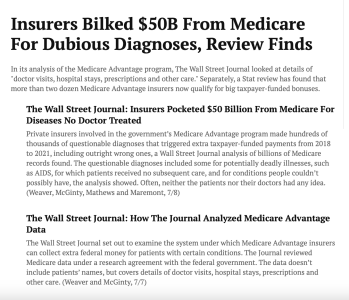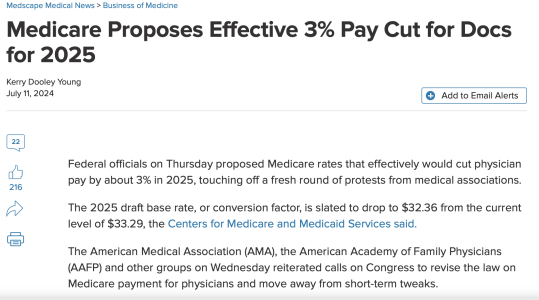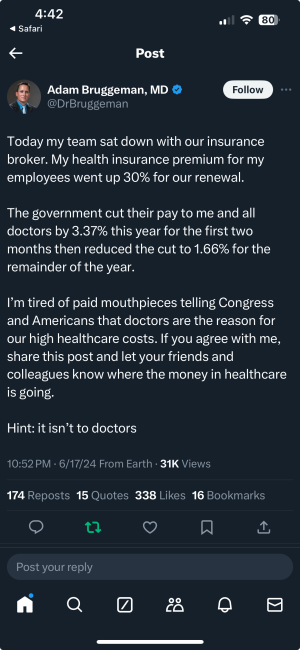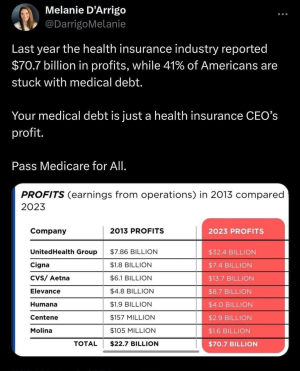You are using an out of date browser. It may not display this or other websites correctly.
You should upgrade or use an alternative browser.
You should upgrade or use an alternative browser.
American Healthcare continues to go backward
- Thread starter steross
- Start date
Surging Hospital Prices Are Helping Keep Inflation High
A 7.7% increase in prices at hospitals last month was the highest in 13 years
One reason U.S. inflation is still high: Increases in prices for procedures to prop open clogged arteries, provide intensive care for newborns and biopsy breasts.
Hospitals didn’t raise prices as early in the pandemic as supermarkets, retailers and restaurants. But they have been making up ground since then. Their increases have contributed to stubbornly high inflation readings from the consumer-price index, which in April increased 3.4% from a year ago.
Hospital prices specifically jumped 7.7% last month from a year ago, the highest increase in any month since October 2010, the Labor Department said Wednesday.
Among the procedures with hefty recent price increases are angioplasties placing stents in arteries to improve blood flow, which grew $670, or 4.5%, to $15,640 in the first three months of the year from the same period a year ago, according to Turquoise Health.
Intensive care of newborns rose during the same period by roughly $200 to $400, or more than 5%, to as much as $7,939 a day, depending on the specific kind of care, according to Turquoise, which analyzed for The Wall Street Journal prices charged by more than 300 hospitals as published by major commercial health insurers. Prices are an average, weighted for hospital size.
Prices for biopsies of the breast using a needle increased $220 during the period, or 4.6%, to $5,027, the Turquoise analysis found.
For patients and their employers, the increases have meant higher health-insurance premiums, as well as limiting wage hikes.
Stillwater Townie
Ranger
It should be no wonder why Ralph Nader wants America to have Medicare For All with participation in it for private health insurance companies not included.
Polds4OSU
Marshall
Florida medical marijuana patients get an unexpected email praising DeSantis
TALLAHASSEE, Fla. (AP) — Florida has more than 700,000 medical marijuana patients and Republican Gov. Ron DeSantis — who is battling a proposal to allow recreational use of marijuana — wants them all to know what a great job he’s doing.
The Department of Health last week sent a blast email to its medical marijuana patient list boasting that DeSantis signed the state budget. The email praised a cancer research program promoted by first lady Casey DeSantis, listed health issues like HIV, hepatitis and syphilis that are in the spending plan and gave a message from Surgeon General Joseph Ladapo that he and DeSantis are “advancing public health and personal responsibility in Florida.”
Nothing in the email mentions medical marijuana, and patients and advocates say that the DeSantis administration violated their privacy by using the patient list to promote policy.
TALLAHASSEE, Fla. (AP) — Florida has more than 700,000 medical marijuana patients and Republican Gov. Ron DeSantis — who is battling a proposal to allow recreational use of marijuana — wants them all to know what a great job he’s doing.
The Department of Health last week sent a blast email to its medical marijuana patient list boasting that DeSantis signed the state budget. The email praised a cancer research program promoted by first lady Casey DeSantis, listed health issues like HIV, hepatitis and syphilis that are in the spending plan and gave a message from Surgeon General Joseph Ladapo that he and DeSantis are “advancing public health and personal responsibility in Florida.”
Nothing in the email mentions medical marijuana, and patients and advocates say that the DeSantis administration violated their privacy by using the patient list to promote policy.
My mother is on medicare advantage. She has multiple times had some random doctor come to her house, ask her a bunch of questions, do a quick exam, and then do nothing and leave. She asked me about it and I told her that the government pays a subsidiary of an insurance company $300 (2019) to do this. That company pays a doc $100 to drive to your house and do the exam.
She has refused it because she currently has a primary care, a ILD pulmonologist, a pulm htn pulmonologist, a rheumatologist, and a cardiologist. What possibly could this visit add to her already burdensome health care? And despite telling them she will not do it anymore, they call her weekly.
Well, the only thing it adds is a bilking of the taxpayer. If that insurance company doc adds some diagnosis to the list, the insurance company can charge the taxpayer more. Even if they don't do any treatment at all!
Gee, that must have taken some payrolled congressmen and awesome lobbyists to rip us off in such a stupid way.

 kffhealthnews.org
kffhealthnews.org
She has refused it because she currently has a primary care, a ILD pulmonologist, a pulm htn pulmonologist, a rheumatologist, and a cardiologist. What possibly could this visit add to her already burdensome health care? And despite telling them she will not do it anymore, they call her weekly.
Well, the only thing it adds is a bilking of the taxpayer. If that insurance company doc adds some diagnosis to the list, the insurance company can charge the taxpayer more. Even if they don't do any treatment at all!
Gee, that must have taken some payrolled congressmen and awesome lobbyists to rip us off in such a stupid way.

Insurers Bilked $50B From Medicare For Dubious Diagnoses, Review Finds - KFF Health News
In its analysis of the Medicare Advantage program, The Wall Street Journal looked at details of "doctor visits, hospital stays, prescriptions and other care." Separately, a Stat review has found that more than two dozen Medicare Advantage insurers now qualify for big taxpayer-funded bonuses.
This could be a sign of how backward it is or a step forward depending on point of view......Drs. are using ChatGPT to get insurance to cover treatment with higher success rates than they have been able to doing it the ol fashioned way.
Might hit a pay wall don't know.....

 www.nytimes.com
www.nytimes.com
Might hit a pay wall don't know.....

In Constant Battle With Insurers, Doctors Reach for a Cudgel: A.I.
As health plans increasingly rely on technology to deny treatment, physicians are fighting back with chatbots that synthesize research and make the case.
We have rampant inflation. We allow hospitals to charge massive facility fees. United Health Care is now the largest employer of doctors in the nation because they are so profitable and are able to buy out medical practices instead of negotiating with them.
Gee, how can we fix this situation of creating near monopoly type power in health care?
Congress has an idea:

Gee, how can we fix this situation of creating near monopoly type power in health care?
Congress has an idea:

Stillwater Townie
Ranger
Cuts need to be found elsewhere. Anyway, it's more important than ever to get on the Republican Health Care Plan--Don't Get Sick! Or Get Hurt! I can only think of changing to a Medicare For All plan, so the private insurance companies and their lobbyists can be happy about being allowed to participate in it.
But at least we don't have those commie death panels.Cuts need to be found elsewhere. Anyway, it's more important than ever to get on the Republican Health Care Plan--Don't Get Sick! Or Get Hurt! I can only think of changing to a Medicare For All plan, so the private insurance companies and their lobbyists can be happy about being allowed to participate in it.
Cuts need to be found elsewhere. Anyway, it's more important than ever to get on the Republican Health Care Plan--Don't Get Sick! Or Get Hurt! I can only think of changing to a Medicare For All plan, so the private insurance companies and their lobbyists can be happy about being allowed to participate in it.
That's just it. Despite rampant inflation, I make less than I made prior to leaving for Australia in 2010. And, if healthcare costs actually went down due to the institution of the ACA, I would accept that as the new normal. But, our HC costs have gotten way worse and the government has just forced all of that money toward corporate profit in place of it going to the people that actually provide the care.
Doesn't the ACA limit the insurance companies profits? Did the republicans get rid of that or did the companies just jack up premiums to increase profits?
Yep, jack up the premiums. Another lesson of the law of unintended consequences when you try to patch a horrible system instead of creating a functioning system.Doesn't the ACA limit the insurance companies profits? Did the republicans get rid of that or did the companies just jack up premiums to increase profits?
They did not cap profits, but they did force them to meet an 80 to 85% medical loss ratio. This is the percent of premiums spent on medical care. For perspective, BC/BS back when they were a real non-profit spent about 95%. Medicare spends 98%.
Prior to the ACA some for-profit insurance was down to the 60% range. The insurers fought against this in the law and it was one of the few battles they lost. But, I suspect they gave in because they knew they had a work-around.
If they are not profit-capped but only limited to a percentage of premiums, instead of controlling costs they benefit by raising costs in the right contracts. This is how you can get insurance paying $100000 for an infusion that might only cost $20000 somewhere else if they are contracted with the right people. On the other hand, they will fight a $20 prescription in other cases.
So, if insurers paid out 1000 one year and then 1500 the next, they can justify raising premiums from 1200 to 1800. Then they get a profit increase from 200 to 300. Therefore, they are better off if costs rise.
Thanks for the explanation. Our gov't is horrible about preventing loopholes.Yep, jack up the premiums. Another lesson of the law of unintended consequences when you try to patch a horrible system instead of creating a functioning system.
They did not cap profits, but they did force them to meet an 80 to 85% medical loss ratio. This is the percent of premiums spent on medical care. For perspective, BC/BS back when they were a real non-profit spent about 95%. Medicare spends 98%.
Prior to the ACA some for-profit insurance was down to the 60% range. The insurers fought against this in the law and it was one of the few battles they lost. But, I suspect they gave in because they knew they had a work-around.
If they are not profit-capped but only limited to a percentage of premiums, instead of controlling costs they benefit by raising costs in the right contracts. This is how you can get insurance paying $100000 for an infusion that might only cost $20000 somewhere else if they are contracted with the right people. On the other hand, they will fight a $20 prescription in other cases.
So, if insurers paid out 1000 one year and then 1500 the next, they can justify raising premiums from 1200 to 1800. Then they get a profit increase from 200 to 300. Therefore, they are better off if costs rise.
PJ-OSU
New member
I'm in the wrong business. That said, I wouldn't have the heart, or lack thereof, to deny very many people help if they needed it.Yep, jack up the premiums. Another lesson of the law of unintended consequences when you try to patch a horrible system instead of creating a functioning system.
They did not cap profits, but they did force them to meet an 80 to 85% medical loss ratio. This is the percent of premiums spent on medical care. For perspective, BC/BS back when they were a real non-profit spent about 95%. Medicare spends 98%.
Prior to the ACA some for-profit insurance was down to the 60% range. The insurers fought against this in the law and it was one of the few battles they lost. But, I suspect they gave in because they knew they had a work-around.
If they are not profit-capped but only limited to a percentage of premiums, instead of controlling costs they benefit by raising costs in the right contracts. This is how you can get insurance paying $100000 for an infusion that might only cost $20000 somewhere else if they are contracted with the right people. On the other hand, they will fight a $20 prescription in other cases.
So, if insurers paid out 1000 one year and then 1500 the next, they can justify raising premiums from 1200 to 1800. Then they get a profit increase from 200 to 300. Therefore, they are better off if costs rise.
Z25
New member
Surging Hospital Prices Are Helping Keep Inflation High
A 7.7% increase in prices at hospitals last month was the highest in 13 years
One reason U.S. inflation is still high: Increases in prices for procedures to prop open clogged arteries, provide intensive care for newborns and biopsy breasts.
Hospitals didn’t raise prices as early in the pandemic as supermarkets, retailers and restaurants. But they have been making up ground since then. Their increases have contributed to stubbornly high inflation readings from the consumer-price index, which in April increased 3.4% from a year ago.
Hospital prices specifically jumped 7.7% last month from a year ago, the highest increase in any month since October 2010, the Labor Department said Wednesday.
Among the procedures with hefty recent price increases are angioplasties placing stents in arteries to improve blood flow, which grew $670, or 4.5%, to $15,640 in the first three months of the year from the same period a year ago, according to Turquoise Health.
Intensive care of newborns rose during the same period by roughly $200 to $400, or more than 5%, to as much as $7,939 a day, depending on the specific kind of care, according to Turquoise, which analyzed for The Wall Street Journal prices charged by more than 300 hospitals as published by major commercial health insurers. Prices are an average, weighted for hospital size.
Prices for biopsies of the breast using a needle increased $220 during the period, or 4.6%, to $5,027, the Turquoise analysis found.
For patients and their employers, the increases have meant higher health-insurance premiums, as well as limiting wage hikes.
Corporate greed has destroyed the U.S. The only way out of this is to nationalize industries such as healthcare.
Nationalize? No, that would be a horrible idea IMO. Single payer system =/= nationalize and has much better outcomes.Corporate greed has destroyed the U.S. The only way out of this is to nationalize industries such as healthcare.
Similar threads
- Replies
- 1
- Views
- 335
- Replies
- 0
- Views
- 303
- Replies
- 27
- Views
- 2K
- Replies
- 6K
- Views
- 221K


